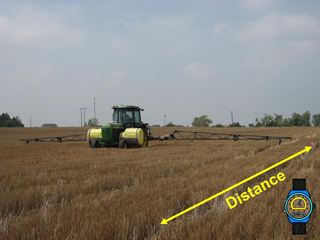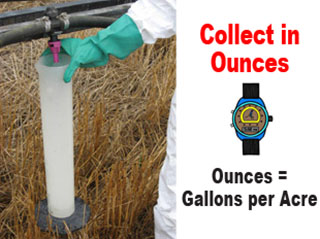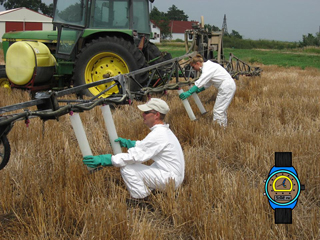G1756
Fine-tuning a Sprayer with the Ounce Calibration Method
This NebGuide offers guidelines to quickly evaluate the performance of a sprayer. Sprayer calibration, nozzle discharge, and speed checks are evaluated with minimal calculations.
Greg R. Kruger, Cropping Systems Specialist
Robert N. Klein, Extension Cropping Systems Specialist
- Calibration — Determining Gallons per Acre
- Nozzle Discharge and Uniformity Check
- Example of Ounce Calibration Method
- Band Sprayer Calibration
- Ground Speed Check
- Conclusions
- Acknowledgment
- Weight and Measures Conversions
Tractor-mounted, pull-type, pickup-mounted, and self-propelled pesticide application equipment are available from numerous sources. Each of these types of sprayers is similar in that proper calibration is necessary to maximize their efficiency. Pesticide costs, potential crop damage, unsatisfactory control, and environmental concerns make correct application important.
Proper calibration to ensure accurate product application must be a primary management consideration for both farmers and custom applicators. Application equipment operators also should know proper application methods, chemical effects on equipment, and correct cleaning and storage procedures for liquid sprayers.
Pesticide application depends on the combination of six basic factors:
- sprayer design,
- nozzle type and spacing,
- boom height,
- boom pressure,
- agitation, and
- ground speed.
When properly mixed and applied, pesticides are expected to return a profit. Improper application can result in wasted chemical; marginal weed, insect, or disease control; excessive carryover; water contamination; and/or selection of resistant biotypes. Inaccurate application can be expensive.
Preseason visual checks of application equipment are not adequate for accurate application, nor is the fact that the equipment and nozzle tips are new. A Nebraska survey found only one of three sprayer operators applying pesticides within five percent of their estimated rate. This survey illustrates that sprayers must be checked to ensure that all nozzles have the correct discharge rate, and are applying pesticides uniformly and at the correct pesticide rate. Manufacturers’ catalogs provide guidelines, but fine-tuning a sprayer is the operator’s responsibility.
Sprayers should be calibrated every time a different pesticide is applied. In addition, a sprayer should be checked at least every other day when in continuous use. Since these checks may have to be performed frequently, evaluating a sprayer quickly and without excessive investment in equipment or calculation is important.
There are a number of calibration techniques. The following describes the Ounce Calibration Method, a means for quick sprayer calibration.
Calibration — Determining Gallons per Acre
The purpose of any calibration method is to determine the number of gallons of spray solution (both pesticide and carrier) being applied per acre. Subsequently, the solution volume applied per acre can be used to determine the quantity of pesticide to be added in the spray tank.
The following method has four steps. No calculations are required. Calibration equipment needed includes a stopwatch, a container to collect nozzle discharge, a tape measure, marking flags, and a container graduated in ounces. The procedure is as follows:
Step 1. Select the travel distance according to the nozzle spacing on the sprayer using Table I. Measure the travel distance in a level field. The travel area should be typical of the surface and soil conditions of the area to be sprayed. Many tractors and sprayers will gain or lose over 10 percent of desired travel speed while moving up and down slopes.
If field variations exist, several speed check areas may be needed. Remember, the time required to drive the travel distance will give the speed of the sprayer, so the measured distance and timing must be exact.
Table I. Calibration distances and speeds for varying nozzle or row spacing. |
|||||||||
Nozzle or Row Spacing (in) |
Calibration Distance (ft) |
Time in Seconds for Various Ground Speeds (mph)* |
|||||||
3.0 |
3.5 |
4.0** |
4.5** |
5.0** |
6.0** |
7.0** |
8.0** |
||
Use 1/2 the time for these mph |
9** |
10** |
12** |
14** |
16** |
||||
40 |
102 |
23.2 |
19.9 |
17.4 |
15.5 |
14.0 |
12.6 |
9.9 |
8.7 |
38 |
107 |
24.3 |
20.8 |
18.2 |
16.2 |
14.6 |
12.2 |
10.4 |
9.1 |
36 |
113 |
25.7 |
22.0 |
19.3 |
17.1 |
15.4 |
12.8 |
11.0 |
9.6 |
34 |
120 |
27.3 |
23.4 |
20.5 |
18.2 |
16.4 |
13.6 |
11.7 |
10.2 |
32 |
127 |
28.9 |
24.7 |
21.6 |
19.2 |
17.3 |
14.4 |
12.4 |
10.8 |
30 |
136 |
30.9 |
26.5 |
23.2 |
20.6 |
18.5 |
15.5 |
13.2 |
11.6 |
28 |
146 |
33.2 |
28.4 |
24.9 |
22.1 |
19.9 |
16.6 |
14.2 |
12.4 |
26 |
157 |
35.7 |
30.6 |
26.8 |
23.8 |
21.4 |
17.8 |
15.3 |
13.4 |
24 |
170 |
38.6 |
33.1 |
29.0 |
25.8 |
23.2 |
19.3 |
16.6 |
14.5 |
22 |
185 |
42.0 |
36.0 |
31.5 |
28.0 |
25.2 |
21.0 |
18.0 |
15.8 |
20 |
204 |
46.4 |
39.7 |
34.8 |
30.9 |
27.8 |
23.2 |
19.9 |
17.4 |
18 |
227 |
51.6 |
44.2 |
38.7 |
34.4 |
31.0 |
25.8 |
22.1 |
19.3 |
16 |
255 |
58.0 |
49.7 |
43.5 |
38.6 |
34.8 |
29.0 |
24.8 |
21.7 |
14 |
291 |
66.1 |
56.7 |
49.6 |
44.1 |
39.7 |
33.1 |
28.3 |
24.8 |
| *1 mph = 88 feet per minute **Note: For times less than 20 seconds, improve accuracy by doubling the collection time (Step 3), and dividing the output collected by two. For times less than 10 seconds, increase the collection time by four times and divide the output collected by four. For 9, 10, 12, 14, and 16 mph, cut the values in half. |
|||||||||
Step 2. Drive and time the sprayer in seconds (Figure 1) at the throttle setting, pressure setting, and load used during spraying (spray tank should be one-half to two-thirds full). Engage incorporation equipment (disks, planter, etc.) or other devices used while spraying. Repeat at least three times and average the results. Do not change the gear or throttle setting after you have chosen a spraying speed. A change in ground speed will change the sprayer application rate and will require recalibration. Equipment with pulse width modulation or spray rate controllers that adjust the flow rate to adapt to a change in ground speed should be calibrated at several speeds. Consult the manufacturer’s guidelines for calibrating these systems.
 |
 |
|
Figure 1. Measure the appropriate length for the nozzle spacing, then measure the time to run the course. |
Figure 2. In a stationary position and with proper boom pressure, measure the output over the same time period used for the run. The number of ounces collected is equal to the gallons per acre. |
Step 3. While in a stationary position, bring the power unit to the proper throttle setting and the sprayer to the boom pressure used in Step 2. Catch the nozzle discharge for the time recorded in Step 2. Measure the discharge in ounces (Figure 2) with a graduated container. For an accurate assessment of the sprayer, measure all nozzles and average the results. Tools such as the SpotOn® Sprayer Calibrator or other devices that quickly determine flow rate can make the job easier.
Remember, from a safety point of view, the collection of discharge should be done using water only! Even while collecting water, use the proper personal safety clothing and protection as equipment may have pesticide residues.
Step 4. The measured ounces from a nozzle are equal to gallons per acre that will be applied. Since this calibration was based on water, conversion factors (Table II) must be used when spraying solutions heavier or lighter than water. Multiply the observed rates of water by the conversion factors to determine the rate of other spray solutions.
Table II. Conversion factors for solutions with densities different than water. |
||
Density of Solution (lb/gallon) |
Example | Conversion Factors |
7.00 |
1.092 |
|
8.00 |
1.021 |
|
8.34 |
Water | 1.000 |
9.00 |
.963 |
|
10.00 |
.913 |
|
10.65 |
28% nitrogen solution | .885 |
11.00 |
7-27-7 fertilizer | .871 |
11.06 |
32% nitrogen solution | .868 |
11.40 |
10-34-0 fertilizer | .855 |
11.50 |
12-0-0-26 fertilizer | .852 |
11.60 |
11-37-0 fertilizer | .848 |
12.00 |
.834 |
|
14.00 |
.772 |
|
Nozzle Discharge and Uniformity Check
|
Check nozzle discharge uniformity (Figure 3) by repeating Steps 3 and 4 for all nozzles. If a single nozzle has a discharge output that is not within ± 5 percent of the average output of all the nozzles, replace the nozzle. If more than one nozzle is not satisfactory, replace all the nozzles. After adjustment or correction, recalibrate.
Example of Ounce Calibration Method
Suppose a sprayer was set up with 30-inch nozzle spacing.
Step 1. Using Table I, 136 feet was marked off and the sprayer was driven through the course three times; the time was recorded and the pressure checked.
Step 2. The average time recorded was 21 seconds and the pressure was 30 PSI. According to Table I, the travel speed was about 4.5 mph.
Step 3. In a stationary position, the sprayer was brought to the proper pressure of 30 PSI. Nozzle outputs were collected for 21 seconds as measured in Step 2. The discharge was measured as:
Nozzles |
Output in ounces for 21 seconds |
1. 2. 3. 4. 5. 6. 7. 8. 9. 10. |
14.5 13.0 15.5 15.0 15.5 15.0 14.5 15.5 14.3 15.2 |
Average = 14.8 ounces +5% = 15.54 ounces -5% = 14.06 ounces |
Step 4. The average of all nozzles was 14.8 ounces. Since nozzle 2 was outside the ± 5 percent satisfactory range, it was replaced with a new nozzle. When checked, the new nozzle had a spray output of 15.0 ounces in 21 seconds. This brought the average for all of the nozzles to 15.0 ounces, so the calibration of the sprayer is 15 gallons per acre.
Suppose the actual carrier were 28 percent fertilizer and not water. The spray volume would need to be adjusted. Using Table II the actual spray volume would be 13.3 GPA for a 28 percent fertilizer solution [15 GPA x .885 (Table II) = 13.3 GPA]. Use this value to determine the proper amount of pesticide to add in the spray tank.
Band Sprayer Calibration
The same calibration method used for broadcast spraying can be used to calibrate band applicators. The only difference is the amount of area being covered.
A broadcast application means the total area or the entire acreage in the field was sprayed. A band application refers to the method that sprays strips or only a portion of the field. A treated acre then refers only to the treated area in the band.
When calibrating a band sprayer, consider that the row spacing and the nozzle spacing are the same. But when banding, the total acres sprayed by a given volume will be greater than if broadcasting. A conversion is necessary to determine the amount of pesticide to be added in the tank. After performing Steps 1 through 4 of the Ounce Calibration Method, multiply the answer (broadcast spray volume) by the appropriate conversion factor (Table III) to determine the band rate.
Table III. Conversion factor to convert broadcast spray volume (gallons per total acre) to band spray volume (gallons per treated acre). |
||||
Band Width (in.) |
Row Spacing (inches) |
|||
20 |
30 |
36 |
40 |
|
8 |
2.5 |
3.8 |
4.5 |
5.0 |
10 |
2.0 |
3.0 |
3.6 |
4.0 |
11 |
1.8 |
2.7 |
3.3 |
3.6 |
12 |
1.6 |
2.5 |
3.0 |
3.3 |
13 |
1.5 |
2.3 |
2.8 |
3.1 |
14 |
1.4 |
2.1 |
2.6 |
2.9 |
15 |
1.3 |
2.0 |
2.4 |
2.7 |
16 |
1.2 |
1.9 |
2.3 |
2.5 |
Unless otherwise specified, chemical application rates are given on a broadcast basis. For band applications, the rate per treated area is the same as the broadcast label rate, but the total amount of pesticide used on a field is less because only a portion of the field is treated.
Ground Speed Check
A survey of spray application equipment indicated 65 percent of the operators had errors of greater than five percent in estimated field travel speed. Step 2 of the described sprayer calibration method provides the actual speed the sprayer was going under field conditions. Because of wheel slippage and rough surface conditions, the actual speed often is lower than the tachometer or speedometer readings. For a more accurate measurement of travel speeds, mark off a distance of 220 feet. Drive and time the operation as in Step 2. The speed is calculated as:
mph = |
150 |
Seconds timed to travel 220 ft |
Conclusions
Calibrate Frequently. The Ounce Calibration Method requires minimal calculations and is recommended for evaluating a liquid sprayer.
Most farmers use the Known Area Calibration Method. This method requires the operator to know a given area, then observe the number of gallons of liquid applied on that area by the sprayer. The gallons per acre can be calculated by dividing the number of gallons applied by the known acres covered.
The Known Area Method is a useful field check, but should not be the primary method because a misapplication error can occur before it can be detected. Use the Ounce Calibration Method; it does not require cumbersome equations or calculations and is simple to use.
Spray equipment in good condition will apply chemicals properly if frequently calibrated and correctly operated. Manufacturers’ manuals include tables to show spray volumes (GPA) for various nozzles, pressures, and ground speeds. Use this information to initially set up the sprayer, then use the Ounce Calibration Method to evaluate and fine-tune the sprayer for accurate application.
Acknowledgment
The authors would like to recognize the contributions of one of the original co-authors of this publication, Robert Grisso, former UNL Extension Agricultural Engineer.
Weight and Measures Conversions
Weight
16 ounces = 1 pound = 453.6 grams"
1 gallon water = 8.34 pounds = 3.78 kilograms
Liquid Measure
1 fluid ounce = 2 tablespoons = 29.57 milliliters
16 fluid ounces = 1 pint = 2 cups
8 pints = 4 quarts = 1 gallon
Length
3 feet = 1 yard = 91.44 centimeters
16.5 feet = 1 rod
5,280 feet = 1 mile = 1.61 kilometers
320 rods = 1 mile
Area
9 square feet = 1 square yard
43,560 square feet = 1 acre = 160 square rods
1 acre = 405 hectare
640 acres = 1 square mile
Speed
88 feet per minute = 1 mph
1 mph = 1.61 km/h
Volume
27 cubic feet = 1 cubic yard
1 cubic foot = 1,728 cubic inches = 7.48 gallons
1 gallon = 231 cubic inches
1 cubic foot = 0.028 cubic meters
Volume/Volume
1/8% = 1/8 gallon (1 pint)/100 gallons
1/4% = 1/4 gallon (1 quart)/100 gallons
1/2% = 1/2 gallon (2 quarts)/100 gallons
1% = 1 gallon/100 gallons
2% = 2 gallons/100 gallons
Common abbreviations and terms used:
GPM = gallons per minute
GPA = gallons per acre
PSI = pounds per square inch
mph = miles per hour
RPM = revolutions per minute
GPH = gallons per hour
FPM = feet per minute
This publication has been peer reviewed.
DisclaimerReference to commercial products or trade names is made with the understanding that no discrimination is intended of those not mentioned and no endorsement by University of Nebraska–Lincoln Extension is implied for those mentioned. |
Visit the University of Nebraska–Lincoln Extension Publications website for more publications.
Index: Farm Power and Machinery
Machinery
2007, Revised November 2013
